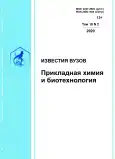Effect of the autohydrolytic treatment of Miscanthus sacchariflorus Andersson on the yield of the reducing substances during the subsequent fermentolysis
- 作者: Pavlov I.N.1
-
隶属关系:
- Institute for Problems of Chemical and Energetic Technologies SB RAS
- 期: 卷 10, 编号 2 (2020)
- 页面: 303-313
- 栏目: Physico-chemical biology
- URL: https://bakhtiniada.ru/2227-2925/article/view/299685
- DOI: https://doi.org/10.21285/2227-2925-2020-10-2-303-313
- ID: 299685
如何引用文章
全文:
详细
作者简介
I. Pavlov
Institute for Problems of Chemical and Energetic Technologies SB RAS
Email: pawlow-in@mail.ru
参考
- Гладышева Е.К., Голубев Д.С., Скиба Е.А. Исследование биосинтеза бактериальной наноцеллюлозы продуцентом Мedusomyces gisevii Sa-12 на ферментативном гидролизате продукта щелочной делигнификации мискантуса // Известия вузов. Прикладная химия и биотехнология. 2019. Т. 9. N 2. С. 260–269. https://doi.org/10.21285/2227-2925-2019-9-2-260-269
- Kashcheyeva E.I., Gismatulina Y.A., Budaeva V.V. Pretreatments of non-woody cellulosic feedstocks for bacterial cellulose synthesis // Polymers. 2019. Vol. 11. Issue 10. P. 1645. https://doi.org/10.3390/polym11101645
- Байбакова О.В., Влияние предварительной обработки энергетической культуры мискантуса на выход биоэтанола // Известия вузов. Прикладная химия и биотехнология. 2018. Т. 8. N 3. С. 79–84. https://doi.org/10.21285/2227-2925-2018-8-3-79-84
- Mahmood H., Moniruzzaman M., Iqbal T., Khan M.J. Recent advances in the pretreatment of lignocellulosic biomass for biofuels and valueadded products // Current Opinion in Green and Sustainable Chemistry. 2019. Vol. 20. P. 18–24. https://doi.org/10.1016/j.cogsc.2019.08.001
- Bychkov A.L., Podgorbunskikh E.M., Ryabchikova E.I., Lomovsky O.I. The role of mechanical action in the process of the thermome-chanical isolation of lignin // Cellulose. 2018. Vol. 25. Issue 1. P. 1–5. https://doi.org/10.1007/s10570-017-1536-y
- Jiang K., Li L., Long L., Ding S. Comprehensive evaluation of combining hydrothermal pretreatment (autohydrolysis) with enzymatic hydrolysis for efficient release of monosaccharides and ferulic acid from corn bran // Industrial Crops and Products. 2018. Vol. 113. P. 348–357. https://doi.org/10.1016/j.indcrop.2018.01.047
- Jiang W., Chang S., Qu Y., Zhang Z., Xu J. Changes on structural properties of biomass pretreated by combined deacetylation with liquid hot water and its effect on enzymatic hydrolysis // Bioresource Technology. 2016. Vol. 220. P. 448–456. https://doi.org/10.1016/j.biortech.2016.08.087
- Gu B.-J., Dhumal G.S., Wolcott M.P., Ganjyal G.M. Disruption of lignocellulosic biomass along the length of the screws with different screw elements in a twin-screw extruder // Bioresource Technology. 2019. Vol. 275, P. 266–271. https://doi.org/10.1016/j.biortech.2018.12.033
- Lyu H., Zhou J., Geng Z., Lyu C., Li Y. Two-stage processing of liquid hot water pretreatment for recovering C5 and C6 sugars from cassava straw // Process Biochemistry. 2018. Vol. 75. P. 202–211. https://doi.org/10.1016/j.procbio.2018.10.003
- Cardona E., Llano B., Penuela M., Juan Pena J., Rios L.A. Liquid-hot-water pretreatment of palm-oil residues for ethanol production: An economic approach to the selection of the processing conditions // Energy. 2018. Vol. 160. P. 441–451. https://doi.org/10.1016/j.energy.2018.07.045
- Da Costa R.M.F., Pattathil S., Avci U., Winters A., Hahn M.G., Bosch M. Desirable plant cell wall traits for higher-quality miscanthus lignocellulosic biomass // Biotechnology for Biofuels. 2019. Vol. 12. Issue 1. Article:85. 18 p. https://doi.org/10.1186/s13068-019-1426-7
- Pavlov I.N., Denisova M.N., Makarova E.I., Budaeva V.V., Sakovich G.V. Versatile thermobaric setup and production of hydrotropic cellulose therein // Cellulose Chemistry and Technology. 2015. Vol. 49. Issue 9-10. P. 847–852
- Batista G.O., Souza R.B.A., Pratto B., Dos Santos-Rocha M.S.R, Cruz A.J.G. Effect of severity factor on the hydrothermal pretreatment of sugarcane straw // Bioresource Technology. 2019. Vol. 275. P. 321–327. https://doi.org/10.1016/j.biortech.2018.12.073
- Sabanci K., Buyukkileci A.O. Comparison of liquid hot water, very dilute acid and alkali treatments for enhancing enzymatic digestibility of hazelnut tree pruning residues // Bioresource Technology. 2018. Vol. 261. P. 158–165. https://doi.org/10.1016/j.biortech.2018.03.136
- Кащеева Е.И., Будаева В.В. Определение реакционной способности к ферментативному гидролизу целлюлозосодержащих субстратов // Заводская лаборатория. Диагностика материалов. 2018. Т. 84. N 10. С. 5–11. https://doi.org/10.26896/1028-6861-2018-84-10-5-11
- Miller G.L. Use of dinitrosalicylic acid reagent for determination of reducing sugar // Analytical Chemistry. 1959. Vol. 31. N 3. P. 426–428. https://doi.org/10.1021/ac60147a030
- Michelin M., Teixeira J.A. Liquid hot water pretreatment of multi feedstocks and enzymatic hydrolysis of solids obtained thereof // Bioresource Technology. 2016. Vol. 216. P. 862–869. https://doi.org/10.1016/j.biortech.2016.06.018
- Moniz P., Pereira H., Duarte L.C., Carvalheiro F. Hydrothermal production and gel filtration purification of xylo-oligosaccharides from rice straw // Industrial Crops and Products. 2014. Vol. 62. P. 460–465. https://doi.org/10.1016/j.indcrop.2014.09.020
- Liu L., Liu W., Hou Q., Chen J., Xu N. Understanding of pH value and its effect on autohydrolysis pretreatment prior to poplar chemithermomechanical pulping // Bioresource Technology. 2015. Vol. 196. P. 662–667. https://doi.org/10.1016/j.biortech.2015.08.034
- Podgorbunskikh E.M., Ryabchikova E.I., Bychkov A.L., Lomovskii O.I. Changes in structure of cell wall polymers in thermomechanical treatment of highly lignified plant feedstock // Doklady Physical Chemistry. 2017. Vol. 473. Issue 1. P. 49–51. https://doi.org/10.1134/S0012501617030046
- Ko J.K., Kim Y., Ximenes E., Ladisch M.R. Effect of liquid hot water pretreatment severity on properties of hardwood lignin and enzymatic hydrolysis of cellulose // Biotechnology and Bioengineering. 2015. Vol. 112. Issue 2. P. 252–262. https://doi.org/10.1002/bit.25349
- Gan S., Zakaria S., Chen R.S., Chia C.H., Padzil F.N.M., Moosavi S. Autohydrolysis processing as an alternative to enhance cellulose solubility and preparation of its regenerated biobased materials // Materials Chemistry and Physics. 2017. Vol. 192. P. 181–189. https://doi.org/10.1016/j.matchemphys.2017.01.012
- Zhu R., Yadama V. Effects of hot water extraction pretreatment on physicochemical changes of Douglas fir // Biomass and Bioenergy. 2016. Vol. 90. P. 78–89. https://doi.org/10.1016/j.biombioe.2016.03.028
- Chena T.-Y., Wena J.-L., Wanga B., Wanga H.-M., Liub C.-F., Suna R.-C. Assessment of integrated process based on autohydrolysis and robust delignification process for enzymatic saccharification of bamboo // Bioresource Technology. 2017. Vol. 244. P. 717–725. https://doi.org/10.1016/j.biortech.2017.08.032
补充文件









